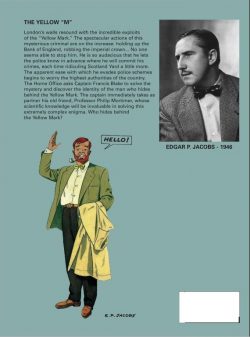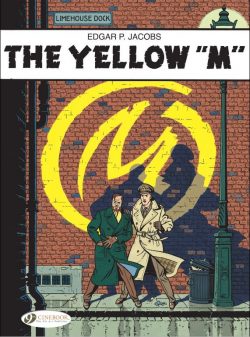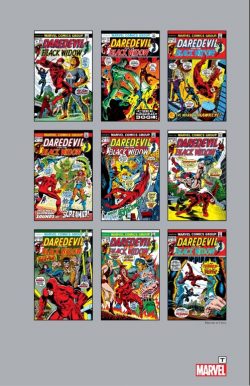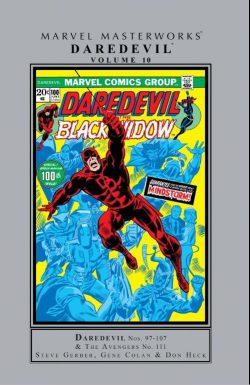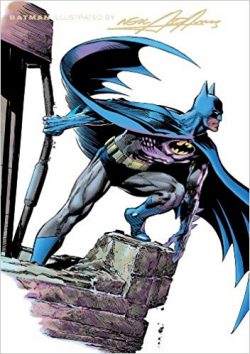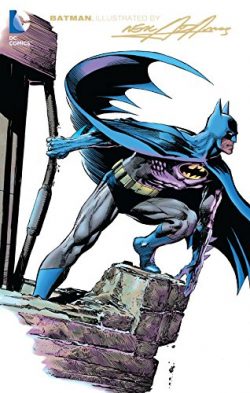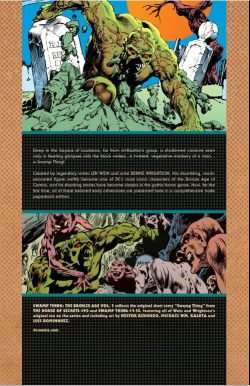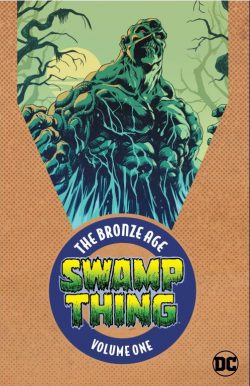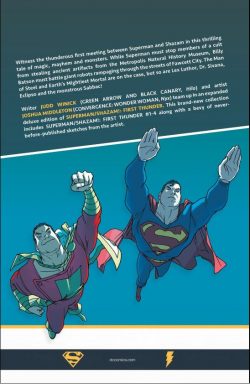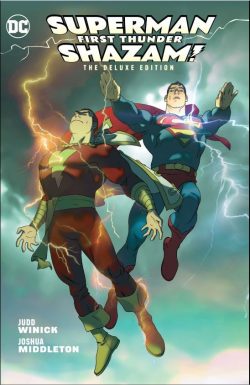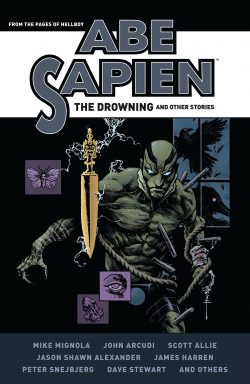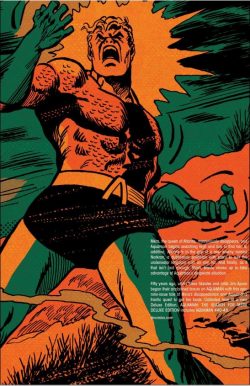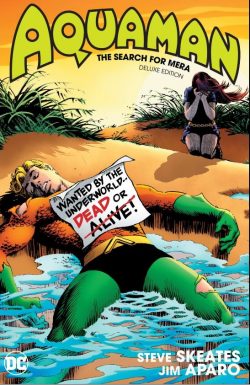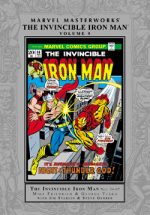

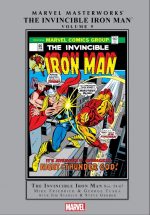
By Mike Friedrich, Jim Starlin, Steve Gerber, Bill Everett, George Tuska, P. Craig Russell, & various (Marvel)
ISBN: 978-0-7851-9190-2 (HB)
Arch-technocrat and supreme survivor Tony Stark has changed his profile many times since his debut in Tales of Suspense #39 (March 1963) when, whilst a VIP visitor in Vietnam observing the efficacy of the munitions he had designed, the inventor was critically wounded and captured by sinister, savage Communists.
Put to work building weapons with the dubious promise of medical assistance on completion, Stark instead created the first Iron Man suit to keep himself alive and deliver him from his oppressors. From there it was a simple jump to full time superheroics as a modern Knight in Shining Armour…
First conceived in the wake of the Cuban Missile Crisis at a time when Western economies were booming and “Commie-bashing†was an American national obsession, the emergence of a new and shining young Thomas Edison, using Yankee ingenuity, wealth and invention to safeguard the Land of the Free and better the World, seemed an obvious development. Combining the then-sacrosanct faith that technology and business in unison could solve any problem, with the universal imagery of noble knights battling evil, Stark – the Invincible Iron Man – seemed an infallibly successful proposition.
Of course, whilst he was the acceptable face of 1960s Capitalism – a glamorous millionaire industrialist/scientist and a benevolent all-conquering hero when clad in the super-scientific armour of his alter-ego – the turbulent tone of the 1970s soon relegated his suave, “can-do†image to the dustbin of history.
With ecological disaster and social catastrophe from the myriad abuses of big business the new zeitgeists of the young, the Golden Avenger and Stark International were soon confronting a few tricky questions from the increasingly politically savvy readership.
With glamour, money and fancy gadgetry not quite so cool anymore the questing voices of a new generation of writers began posing uncomfortable questions in the pages of a series that was once the bastion of militarised America …
This grand and gleaming chronological compendium – available in hardback and digital editions – navigates that transitional period; reprinting Iron Man #54-67 (January 1973 to April 1974) and offering tone and context for the times comes courtesy of main writer Mike Friedrich’s Introduction.
Issue #54 found Stark in California and drawn into what became one of Marvel’s most successful crossover epics. ‘Sub-Mariner: Target for Death!’ debuted pitiless alien researcher Madame MacEvil – later re-branded during the Thanos Saga as Moondragon after this opening salvo – a bald, sexy siren who manipulated Iron Man into attacking the Prince of Atlantis in a spectacular bout with the bonus of additional art from the legendary Bill Everett supplementing the efforts of Friedrich, George Tuska & Vince Colletta…
The Thanos story moved into full gear in Iron Man #55, as Friedrich scripted illustrator Jim Starlin’s opening gambit ‘Beware The… Blood Brothers!’ introducing haunted humanoid powerhouse Drax the Destroyer, trapped by extraterrestrial invader Thanos under the Nevada desert and in dire need of rescue…
(This was all merely a prelude to the full saga which appeared in Captain Marvel #25-33, Marvel Feature #12 and Avengers #125, and has been collected in such compilations as The Life of Captain Marvel and others.)
Iron Man #56 was a literally magical palate-cleanser, as Steve Gerber joined Starlin & Mike Esposito to tell the satirically hilariously tragedy of ‘Rasputin’s Revenge’, wherein a street corner doom-prophet accidentally gains the power to fulfil his prognostications but still falls sadly short of engineering the apocalypse…
It was back to business as usual with Gerber, Tuska, Esposito & Frank Giacoia in #57 as a devastating ‘Strike!’ hits troubled Stark Industries, engineered by an insidious old enemy who inevitably overplays his be-ringed hand in concluding episode ‘Mandarin and the Unicorn: Double-Death!’ (with Friedrich returning to script Gerber’s plot) after which ‘A Madness in Motown!’ sees Stark battling the revenge-maddened anti-capitalist Firebrand whilst unknowingly falling for the torrid terrorist’s sister Roxie Gilbert.
Another 2-part clash follows – this time against a deadly technology-thief – which began with ‘Cry Marauder!’ after a masked malcontent steals Stark’s experimental space shuttle, culminating in ‘Death Knells over Detroit!’ as the purloined prototype is unerringly aimed like a monstrous missile into the heart of Motor City, leaving a crippled Iron Man only seconds to save the day…
Don’t fret folks; it all turned out alright in the end…
With Mike Friedrich scripting, the action stays in Detroit where Stark is inspecting one of his factories until former Maggia assassin ‘Whiplash Returns!’ (illustrated by P. Craig Russell, Esposito, Giacoia & John Romita Sr.). The crazed killer is raging for revenge and especially ticked off that his girlfriend has been made his boss…
An extended epic began in #63 with ‘Enter: Dr. Spectrum’, illustrated by Tuska & Esposito. Here, as Stark relentlessly – and fruitlessly – romantically pursues pacifist dissident Roxie Gilbert in Detroit, obnoxious Ugandan financier and diplomat Dr. Kinji Obatu visits the Long Island plant and is attacked by a gang of masked thugs.
The assault is repelled thanks to the timely assistance of stand-in Iron Man Eddie March, who is promptly offered a bodyguard job by the creepy ambassador and invited to accompany him to a meeting with Stark in “Motor Cityâ€.
On arrival, photonic fiend Dr. Spectrum ambushes the inventor, before being driven off by the Armoured Avenger after a titanic and costly struggle. A far more serious problem emerges later when old friend Happy Hogan accuses Tony of having an affair with his wife Pepper…
Spectrum strikes again in the next issue, with a similar lack of success, before Happy blows his top and takes a swing at Stark, but that confrontation is curtailed when a gigantic monster kidnaps the just-arrived Obatu in ‘Rokk Cometh!’ When the beast targets Roxie, the exhausted Iron Man intervenes but is too drained to resist the relentless Spectrum…
Issue #65 exposes ‘The Cutting Edge of Death!’ when the Golden Avenger learns the true parasitical nature of Spectrum’s Power Prism as it transfers itself from the wilfully disobedient villain Obatu to the worn-out hero.
Its glee is short lived though, as the possessed Iron Man is challenged by recently arrived comrade Thor, resulting in a blockbusting ‘Battle Royal!’ which only ends after the Thunderer crushes the crystal conqueror to discovered the dying man inside the armour is neither Stark nor Obatu…
As a consequence of that climactic clash of myth and mechanism, IM #67 sees the impostor Iron Man temporarily mutated by Stark’s medical miracle machine the Cobalt Enervator into a rampaging monster in ‘Return of the Freak!’ but no sooner do the genuine Armoured Avenger and surgeon Don Blake (who we all know was Thor back then) stop and save the berserk victim than Stark is drawn into another conflict in South East Asia…
To Be Continued…
With this volume (which also offers a stunning original art gallery of pages and covers by Tuska, Everett, Starlin, Romita and Gil Kane), Marvel completely entrenched itself in the camp of the young and the restless who experienced at first hand and every day the social upheaval America was undergoing.
Their rebellious teen sensibility and increased political conscience permeated the company’s publications as their core audience moved beyond Flower Power protests towards a generation of acutely aware activists. Future tales would increasingly bring reformed capitalist Stark into many unexpected and outrageous situations…
But that’s the meat of another review, as this engrossing graphic novel is done. From our distant vantage point the polemical energy and impact might be dissipated, but the sheer quality of the comics and the cool thrill of the eternal aspiration of man in perfect partnership with magic metal remains.
These Fights ‘n’ Tights classics are amongst the most underrated but impressive tales of the period and are well worth your time, consideration and cold hard cash…
© 1973, 1974, 2017 Marvel Characters, Inc. All rights reserved.

